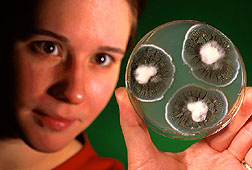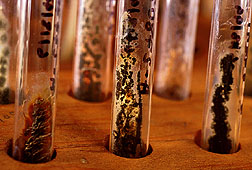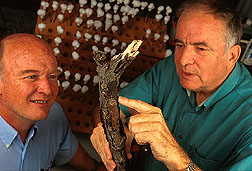In Search of Useful Fungi
|
|
A treasure trove of microbes known as the ARS Culture Collection has now become richer, thanks to the teamwork of ARS scientists and others who found them by relishing science and its problem-solving potential.
The recent additions, including many Penicillium species, came from far and wide. And several came from Peoria, Illinois—home of the collection located at the National Center for Agricultural Utilization Research.
The upsurge in fungal accessions started with NCAUR microbiologist Donald T. Wicklow's longstanding interest in the fungus Aspergillus flavus. A journey of the mind then led him and his colleagues to discover antifungal compounds in surprising places.
A. flavus is fungus non grata because it produces aflatoxin, a hazardous substance that poses a health risk if it gets into food or livestock feed. In corn, cotton, and peanut fields infested with A. flavus, the fungus survives extensive droughts or freezing temperatures by forming a hardened protective structure called a sclerotium. In the late 1980s, Wicklow teamed up with University of Georgia plant pathologist David M. Wilson to research the long-term survival of A. flavus in the soils of Illinois and Georgia crop fields. Wilson is stationed at the Coastal Plains Research Station in Dawson, Georgia. They buried, for later retrieval, tea strainers containing soil with added laboratory-raised sclerotia.
"Though 3 years later many of the sclerotia still survived, we were pleased to discover that these hardy life forms were under attack by numerous mycoparasitic fungi, including Humicola fuscoatra," says Wicklow. The researchers went on to identify antifungal chemicals that H. fuscoatra used to kill A. flavus.
|
|
Noting that long-lived fruiting bodies of some wood-decay fungi are structurally similar to the sclerotia, the scientists came upon an idea. Inasmuch as the coffee-ground-size black sclerotia were dispersed as widely as just one per pound of soil, wouldn't it be easier to collect the long-lived fungal bodies on decaying wood and attempt to recover parasitic fungi? Wicklow shared the idea with Harry Thiers, a mushroom expert who had been his academic advisor at San Francisco State College in the 1960s. Just retired, Thiers had moved to Peoria, his wife's hometown. He became involved as an ARS scientific volunteer, an endeavor that included collecting mushrooms.
Thiers camped in one state park after another across New Mexico, Colorado, and several midwestern States. Within 2 summers, he had collected about 200 specimens of wood-decay fungi, including several from a woody ravine behind his house.
Though not specimens that most collectors would seek, these old wood-decay fungi held a rich array of Wicklow's fancies. He and undergraduate assistant Eileen Bayer isolated about 600 different microscopic fungi from these specimens.
The NCAUR team is working with natural product chemist James B. Gloer of the University of Iowa at Iowa City, who has support for the project from the National Science Foundation to discover novel chemicals that inhibit the growth of A. flavus and Fusarium verticillioides (formerly known as F. moniliforme).
These are two of the most important mycotoxin-producing fungi that infect corn kernels. Thus far, the scientists have extracted, from the microscopic wood-decay fungi, dozens of chemicals with novel structures that work against the grain-infecting fungi.
With additional support from the Biotechnology Research and Development Corporation in Peoria, Wicklow's team has produced thousands of extracts from these 600 fungal cultures and others and has shared those extracts with BRDC member companies. The companies have been screening them for production of chemicals that might serve as agricultural pesticides, animal health products, and antifungal antibiotics.
Brand-New Penicilliums!
While isolating and examining the fungi Thiers had collected, Wicklow found that 91 strains fit into the genus Penicillium. He supplied the isolates to NCAUR microbiologist Stephen W. Peterson for further examination.
|
|
Using an automated DNA sequencer, Peterson compared sequences of particular genes in the isolates to those of analogous genes in archived Penicillium cultures in the ARS Culture Collection.
"I was surprised to find that many of the isolates Thiers had obtained didn't correspond to known species," Peterson says. "We then determined additional gene sequences that helped us verify the unique positions of these isolates in the phylogenetic tree of Penicillium species. Phylogenetic trees are charted depictions of evolutionary relatedness."
"When we found so many Penicillium fungi taken from fruiting bodies of wood-decaying fungi, we realized we had come upon an untapped resource," says Wicklow. Until then, scientists had mainly focused on Penicillium from moldy food, moldy livestock feed, and soil samples. From the 91 strains taken from the unusual setting, Peterson found 39 species that were new to science.
The researchers are developing detailed descriptions of these new fungi, integrating physiological data and observations from scanning electron microscopy and light microscopy with DNA sequence analysis.
By using modern microbiological tools, the NCAUR scientists, in one fell swoop, ran into the largest discovery of new Penicillium species described by any person or group since the genus was first described in H.F. Link's dissertation in 1809. Peterson added the new species to the ARS Culture Collection's 102 previously known Penicillium species, including those that scientists at NCAUR used to help launch the antibiotics industry a half century ago.
"The addition of so many new species will greatly add to our knowledge of the genus from which penicillin was obtained," says Peterson.
"Integrating what we know into a new, comprehensive identification system may help us to find more useful Penicillium isolates from nature."—By Ben Hardin, Agricultural Research Service Information Staff.
This research is part of two ARS National Programs: Plant, Microbial, and Insect Genetic Resources, Genomics, and Genetic Improvement (#301), described on the World Wide Web at http://www.nps.ars.usda.gov/programs/cppvs.htm, and Food Safety (#108), described at http://www.nps.ars.usda.gov/programs/appvs.htm.
Donald T. Wicklow and Stephen W. Peterson are at the USDA-ARS National Center for Agricultural Utilization Research, 1815 N. University St., Peoria, IL 61604; phone (309) 681-6243 [Wicklow] and (309) 681-6384 [Peterson], fax (309) 681-6686.
"In Search of Useful Fungi " was published in the November 1999 issue of Agricultural Research magazine.









